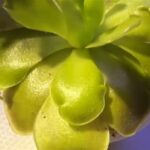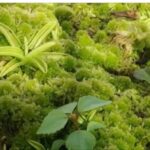As an Amazon Associate, this site earns commissions from qualifying purchases. For more details, click here.
Drosera filiformis is probably best known for their tentacles which can grow up to 18 inches. Also known as Thread-leaf sundews, these plants come in several variants and forms which may confuse a beginner. In this guide you will learn the necessary steps to care for D. filiformis and D. tracyi and how to distinguish the different needs of its variants.
Drosera filiformis requires partial to full light, with a temperature range of 60-80 degrees F. Humidity should be at least 50% and the soil mix 1:1 peat moss and perlite.
Drosera Filiformis Care Sheet
| Soil | 60% peat, 40% perlite, soil should be moist |
| Water | Rainwater, distilled water |
| Light | Full light, 6-8 hours, natural or indoor grow lights |
| Food | Insects, dried mealworms, fish flakes |
| Temperature | 60-80 F (15.5-26.6 C) |
| Humidity | 80% |
| Dormancy | Yes |
| Propagation | Seeds |
Drosera Filiformis vs. Drosera Tracyi
D. filiformis and D. tracyi have many similarities but also differences. D. tracyi grows in the Louisiana coast, Florida and Georgia. D. filiformis is located along the Atlantic coast and parts of Florida.
D. filiformis in Florida (called D. filiformis var. floridana or Florida Red) is redder than the D. filiformis in the Atlantic, and they are not as large either.
It is possible to produce hybrids from D. filiformis and D. tracyi and many have done so. The result is Drosera California Sunset. California Sunset has stronger resistance to winter freeze than D. filiformis or D. tracyi. Breeding between D. intermedia and D. filiformis will produce Drosera hybrida.
Lighting Requirements
Drosera filiformis needs 6-8 hours of light a day, with sunny conditions ideal for growth. These sundews prefer full light, though partial shade is recommended in very high temperature.
These sundews are native to wet bogs and similar locations. However they seem to cope better in drier conditions than other drosera. Most of them flourish outdoors in sunlit skies, though you can grow them indoors on a windowsill.
Most variants of D. filiformis require several hours of light daily, 8 or more is better. If the plant is a pinkish silver and the tentacles are bright red, it is getting sufficient light.
If your area gets limited light, artificial lights may be used. A 40W or a powerful fixture like the Barrina grow light is recommended. Since these plants go dormant in winter you do not have to worry about lighting. But you can use artificial sources if sunlight hours is limited even during the other seasons.
Soil and Pot Size
The best soil for drosera filiformis is peat and perlite. You can use a 1:1 mix or 60% peat and 40% perlite. Do not use regular potting or enriched soil. The minimum pot size is 2.5 inches.
D. filiformis is sensitive to media so stick with peat and perlite. If you bought one and the plant looks healthy, do not tamper with it. Use the same type of soil if you have to repot. Only adjust the mixing ratio if the sundew seems to be struggling.
Most D. filiformis and variants grow fine in 2.5-3 inch pots. Use a 6 inch pot if you plan to grow multiple sundews in one pot. Try not to squeeze too many seeds in one container as these plants can grow quite large.
Fertilizer. All sundews including D. adelae do not need fertilizers. The only safe one you can use is Maxsea but the plant will grow without it. As long as the environment is suitable your D. filiformis will live.
Watering. Use only pure water, rain water or reverse osmosis. Never use tap water and keep the soil moist at all times. It is true that D. filiformis handles drier soil better than other sundews. But you can never let the soil go 100% dry.
Temperature and Humidity
The Drosera filiformis thrives in 60-80 F temperature, but most variants will be fine up to 90 degrees or as low as 40 F. The humidity can be at 50% provided the weather is cool.
If you want to grow D. filiformis outdoors, choose a sunny spot and it should be fine. Only provide shade if the temperature breaks above 90 F or the plant is showing signs of weakness. The sundew should be pinkish silver with red tentacles so use that as a barometer.
The greater the light intensity the higher the temperature usually goes, and this is where humidity comes in. You can keep the humidity at 50% as long as the temperature stays at 80 F or lower.
There are two ways to increase the humidity: use a humidifier and the tray method.
The tray method is the simplest and usually most effective. Any plastic tray will do as long as it is taller than the sundew pot. Pour water into the tray and the pot hole will allow the water to get into the roots and leaves.
Pour an inch of water in the tray for a 2.5-3 inch pot. Increase the water level to 2 to 3 inches for a 6 inch container. There are no hard rules here, let the soil moisture be your guide. If the soil sticks to your fingers and feels damp, that is enough. During hot days, D. filiformis will need soggier soil.
Feeding
All variants of D. filiformis and D. tracyi can catch insects without any help. You should only feed the plant if they are unable to do this .Regularly fed sundews grow faster, produce more dew and are healthier.
Insects make up most of their diet, but you can also use fish flakes and Jessi Mae Freeze Dried mealworms. These plants eat living and dead bugs alike. No matter what you feed them, wait for dew to appear on the leaves before giving any food.
Dormancy and Flowering
Drosera filiformis requires dormancy. Wait for the winter hibernacula to appear then press it into the soil during early spring. The plant will emerge again in mid to late spring and produce flowers in May or June.
Before proceeding, please check which hardiness zone you live in. This will determine how well your sundew can tolerate the cold.
Dormancy care tips for Drosera filiformis, D. tracyi and other variants:
- D. filiformis and D. tracyi produce winter hibernacula, but D. tracyi cannot survive long deep winters. Move the plant indoors during a heavy freeze.
- D. filiformis in the Atlantic coast can stay outdoors the entire year if you are in USDA zone 6 or 7. Move the sundew indoors if you are in a colder zone. Do this once the plant has entered dormancy, not before.
- Some D. filiformis forms may not survive a late spring frost so keep them indoors as long as needed.
- If you are in zone 9 or a warmer location, D. filiformis may be left outdoors.
- Some D. filiformis variants like floridana cannot handle winter in zone 8.
- D. tracyi should be fine outdoors in zone 9. But the sundew may struggle if the winter is short and followed by a wet spring.
As you can tell, dormancy requirements depend on the variant and the USDA hardiness zone. To keep it simple, if the D. filiformis variant is native to your region, it can probably handle the winter outdoors. if you are not sure, bring it indoors but store in a cool place.
Propagation
D. filiformis and D. tracyi are usually propagated with seeds. Collect the flower seeds and subject them to cold stratification for a month or so.
There are three ways to do cold stratification:
- Put the seeds in a refrigerator
- Leave the seeds outside during winter
- Get a plastic bag and put the seeds there. Put the bag on wet peat moss then store it in the fridge.
After four weeks, remove the seeds. Put peat moss soil in a pot and place the seeds on the soil. Do not bury the seeds in the soil. Leave the pot outdoors during winter. Doing this will allow the seeds to emerge during spring.
Conclusion
Growing and caring for D. filiformis can be easy with thorough planning and preparation. While general care for each variant is the same, they are some differences when it comes to dormancy. Knowing the characteristics specific to your D. filiformis is key.

My fascination with carnivorous plants began many, many years ago with Venus Fly Traps. Now I am more than happy to impart what I know with other enthusiasts and those who are curious about meat eating plants.



